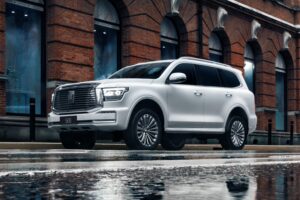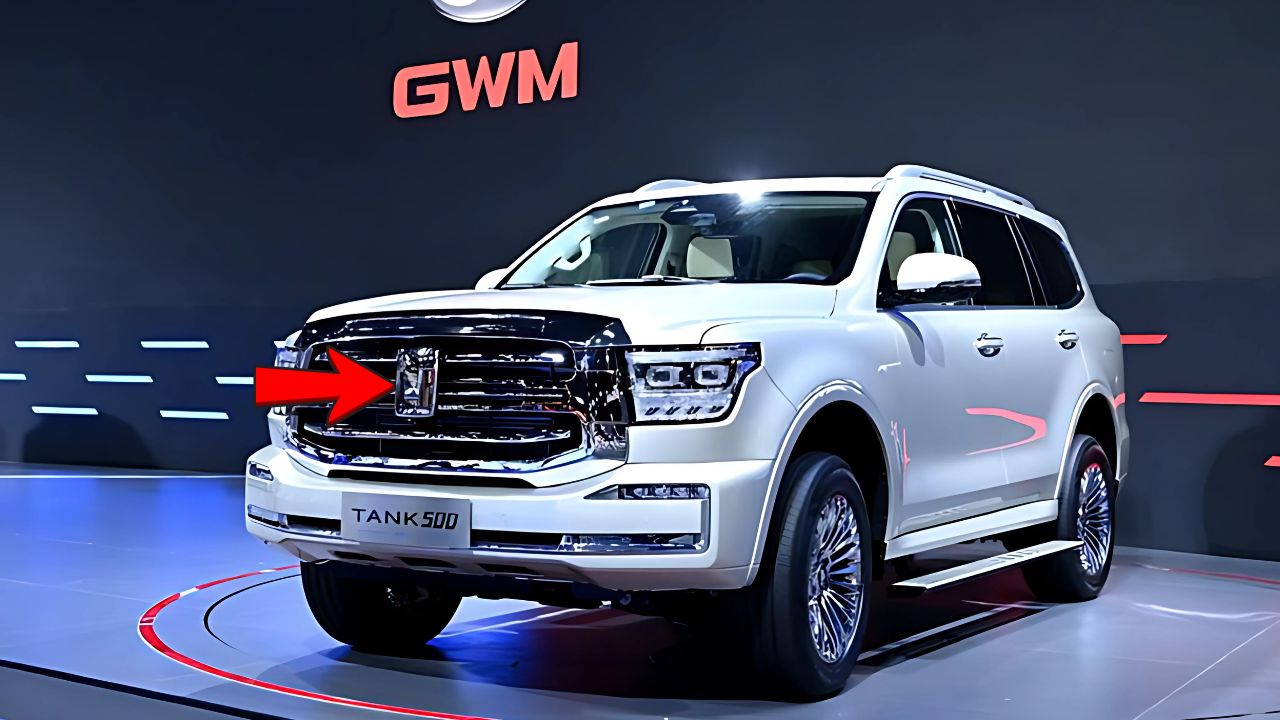Great Wall Motor’s (GWM) flagship off-road SUV, the Tank 500, has been spotted undergoing testing in China, revealing a significant facelift that promises advanced technological upgrades and a refreshed design. The prototype, lightly camouflaged, features mysterious sensors, including a roof-mounted lidar unit and side cameras, hinting at a leap in driver assistance technology. With a redesigned interior, updated styling, and robust powertrain options, the 2025 GWM Tank 500 is poised to strengthen its position as a premium, rugged SUV in markets like Australia, where it competes with the likes of the Toyota Prado and Ford Everest. This article delves into the details of the spied update, its potential impact on the Australian market, and why the Tank 500’s technological advancements are generating buzz in the automotive world.
A Glimpse of the Future: Spy Shots Reveal Key Updates
The GWM Tank 500, launched in Australia in March 2024, has already made waves as a capable and value-driven alternative to established off-road SUVs. Recent spy photos, published by CarNewsChina.com on June 4, 2025, show a facelifted version of the Tank 500 undergoing testing in China, sporting subtle exterior changes and intriguing new technology. The most eye-catching feature is a roof-mounted lidar sensor, likely the compact ATX model from Hesai Technology, suggesting that GWM is preparing to introduce advanced driver assistance systems (ADAS) beyond the current Level 2 capabilities.
Additionally, camouflaged sections on the front guards conceal what appear to be side cameras, indicating a potential 360-degree camera system or enhanced autonomous features. These sensors point to a suite of cutting-edge technologies, possibly including “hands-off” driving modes for mapped highways, automatic lane-changing, and merging capabilities, which are becoming common in China’s competitive EV and hybrid markets. The Tank 500’s facelift also includes a remodelled interior, a new two-spoke steering wheel, and a simplified center console, aligning it with modern design trends seen in other GWM models.
Exterior Styling: Subtle Yet Significant
While the Tank 500 retains its signature boxy, rugged profile, the facelifted model introduces subtle exterior refinements. The front grille, partially covered in the spy shots, appears to adopt a simpler four-bar design compared to the nine-bar grille used in earlier Australian models. This aligns with the “sports grille” introduced on Chinese-market Tank 500 Hi4-T plug-in hybrid (PHEV) models, which entered production in April 2025. The new grille features chunkier horizontal slats, maintaining the chrome-heavy aesthetic that positions the Tank 500 as a premium Toyota Prado rival.
The spied prototype also showcases multi-spoke silver alloy wheels, larger than the 18-inch wheels standard in Australia, suggesting that 19- or 20-inch options may become available. Other exterior elements, such as the vertical taillights and tailgate-mounted spare tire, carry over unchanged, preserving the Tank 500’s rugged identity. The vehicle’s dark green exterior color, a new addition, adds a fresh aesthetic option for buyers seeking a distinctive look.
Interior Overhaul: Modern and Functional
Inside, the Tank 500 facelift promises a significant upgrade. The spied prototype reveals a redesigned interior with a focus on modernizing the cabin while maintaining its premium appeal. The most notable change is the adoption of a larger, freestanding infotainment screen that rises from the dashboard, replacing the integrated dual-screen setup of the current model. This design mirrors trends seen in other Tank models, such as the Tank 300 facelift, and aligns with consumer demand for larger, more intuitive displays.
The center console has been reconfigured for simplicity, with drive mode controls, off-road settings, and hybrid mode selectors streamlined into a cohesive layout. The steering wheel now features a two-spoke design, enhancing the modern aesthetic and improving driver ergonomics. These changes suggest that GWM is addressing feedback about the Tank 500’s interior, aiming to offer a more user-friendly and luxurious experience for buyers in markets like Australia, where interior quality is a key purchasing factor.
Powertrain Options: Continuity with Potential Enhancements
The facelifted Tank 500 is expected to retain its existing powertrain lineup, which includes both internal combustion engine (ICE) and hybrid options tailored for off-road performance. The current lineup, as available in China, includes:
-
3.0T V6 Mild Hybrid: Delivering 265 kW and 500 Nm, paired with a 9-speed automatic transmission, this powertrain offers robust performance for demanding terrains.
-
Hi4-T Plug-in Hybrid: Combining a 2.0T engine with a front-mounted electric motor, this system produces 300 kW and 750 Nm, with a 37.1 kWh battery offering a 110 km electric-only range.
-
Hi4-Z Plug-in Hybrid: Utilizing an 800V platform with dual electric motors and a 2.0T engine, this high-performance option delivers 635 kW and 1,195 Nm, with a 201 km electric-only range and a total range of 1,096 km (WLTC).
The Hi4-Z system, with its larger 59.05 kWh battery, offers better weight distribution and a safer battery placement, enhancing off-road capability. However, the Hi4-T, used in the Australian-market Tank 500 PHEV, places the battery under the rear boot, slightly reducing cargo space compared to the Hi4-Z. While the spied prototype’s powertrain details remain unconfirmed, the presence of advanced sensors suggests that GWM may enhance the hybrid systems with improved software or efficiency tweaks.
Advanced Driver Assistance: The Role of Lidar and Sensors
The most exciting aspect of the Tank 500 facelift is its potential for advanced driver assistance systems. The roof-mounted lidar sensor, likely from Hesai Technology, indicates that GWM is aiming for Level 3 or higher autonomy in certain conditions, such as on mapped highways in China. Lidar, which uses laser pulses to create detailed 3D maps of the environment, enhances the accuracy of features like adaptive cruise control, lane-keeping assist, and automatic emergency braking. The side cameras, possibly part of a 360-degree camera system, could support advanced functions like automated parking or low-speed off-road navigation.
In China, vehicles equipped with such technology often feature “hands-off” driving modes, allowing automatic lane changes and highway merging. While these features may be limited to specific markets due to regulatory differences, their inclusion in the Tank 500 could position it as a technological leader in the off-road SUV segment. For Australia, where the Tank 500 already received a software update in December 2024 to address overzealous safety features, these advancements could further refine the driving experience.
Off-Road Capability: Built for Australia’s Terrain
The Tank 500’s off-road prowess remains a key selling point, particularly in Australia, where rugged landscapes demand capable vehicles. The current model boasts an 800 mm wading depth, a 223 mm ground clearance (11 mm less than the Hi4-Z), and competitive approach and departure angles. The facelifted model is expected to maintain these specifications, with the Hi4-Z variant offering improved weight distribution for better off-road performance.
The inclusion of advanced sensors could also enhance off-road functionality. For example, lidar and side cameras could support low-speed terrain mapping, helping drivers navigate challenging trails with greater precision. This would align with the Tank 500’s positioning as a direct competitor to the Toyota Prado and Ford Everest, both of which are popular for their off-road capabilities in Australia.

Market Impact and Pricing
In China, the Tank 500 is priced at approximately 335,000 yuan (USD 46,500), but the addition of lidar and advanced ADAS could increase costs for the facelifted model. In Australia, the current Tank 500 starts at around AUD 66,000, offering strong value compared to the Prado (from AUD 62,000) and Everest (from AUD 53,000). The facelift’s upgraded technology and interior could push the price higher, but GWM’s focus on affordability suggests it will remain competitive.
The Tank 500’s sales performance in China—3,350 units in April 2025—indicates strong demand in the off-road SUV segment. In Australia, GWM has worked to address early criticisms, with software updates in December 2024 improving safety features like adaptive cruise control and lane-keep assist, which were deemed too intrusive. The facelifted model’s advanced tech could further boost its appeal, particularly for buyers seeking a premium yet affordable alternative to established brands.
Challenges and Opportunities
While the Tank 500 facelift promises exciting upgrades, GWM faces challenges in ensuring these technologies meet Australian regulations and consumer expectations. The “hands-off” driving features seen in China may not be fully implementable in Australia due to stricter autonomous driving laws. Additionally, the placement of the battery in the Hi4-T PHEV, which reduces cargo space, could be a drawback for buyers prioritizing practicality.
However, the facelift presents significant opportunities. The Tank 500’s combination of advanced tech, off-road capability, and competitive pricing could attract buyers in Australia’s growing SUV market. GWM’s commitment to local tuning, as seen in the December 2024 software update, suggests that the facelifted model will be optimized for Australian conditions, enhancing its appeal to off-road enthusiasts and families alike.
In Summary
The 2025 GWM Tank 500 facelift, spotted testing in China, signals a bold step forward for GWM’s flagship SUV. With mysterious sensors like lidar and side cameras, a redesigned interior, and subtle exterior updates, the Tank 500 is set to offer advanced driver assistance and enhanced user experience. While retaining its robust powertrain options and off-road capability, the facelifted model could solidify GWM’s position as a serious contender in Australia’s competitive SUV market. As the Tank 500 prepares to take on rivals like the Toyota Prado and Ford Everest, its blend of technology, value, and ruggedness makes it a vehicle to watch in 2025 and beyond.
